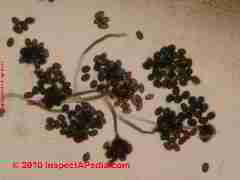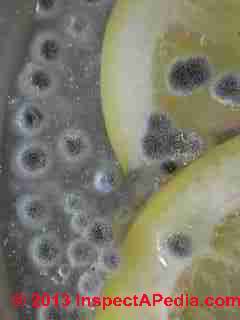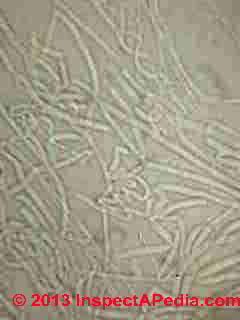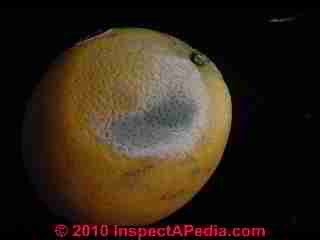 Mold-Related Illnesses
Mold-Related Illnesses
Mold Hazards in Foods
- POST a QUESTION or COMMENT about mold-related illnesses traced to foods, aflatoxins, and related substances
Mold-related illness: aflatoxins & food mold hazards:
Here we list major outbreaks of disease, illness, deaths caused in humans and other animals due to eating moldy foods. Our page top photograph shows green and white Penicillium sp. mold growing on an orange.
History of major mold illness outbreaks . References to mold related illness key documents & Standards. What are the mold dangers in food: grains, cake mixes, fruits, cheeses, miso, drinks?
InspectAPedia tolerates no conflicts of interest. We have no relationship with advertisers, products, or services discussed at this website.
- Daniel Friedman, Publisher/Editor/Author - See WHO ARE WE?
Human & Animal Diseases Caused by Mold - A Summary of Risks, History of Mold Related Illnesses, Resources
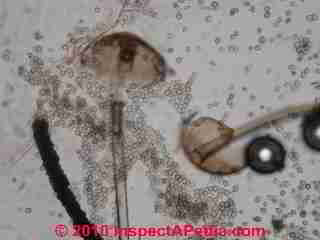 Recent near-panic media reports of dangerous mold in pancake mix and cake batters need to be understood with an accurate perspective on the hazards to humans or other animals from eating moldy foods. Here we provide a brief history of major mold-related-illness outbreaks and additional detail on mold toxicity associated with food products.\
Recent near-panic media reports of dangerous mold in pancake mix and cake batters need to be understood with an accurate perspective on the hazards to humans or other animals from eating moldy foods. Here we provide a brief history of major mold-related-illness outbreaks and additional detail on mold toxicity associated with food products.\
[Click to enlarge any image]
People who do not have a mold allergy eat moldy food without issue - such as blue cheese; people in developing countries survive eating moldy food and fruit thrown into waste bins.
Harmless or Helpful Molds
There are plenty of molds that grow on and in foods that are harmless, and many many foods whose preparation deliberately involves the action of mold- Camembert and Roquefort cheese, Quorn microprotein, Rhizopus oligosporous used to make tempeh, Aspergillus oryzae used in the production of Miso and other soy products.
Our photo (above left) is of Rhizopus sp. -DJF
Cosmetic "black mold" has been a cause of unnecessary building "mold remediation" expense in some cases - See Recognize Cosmetic Mold
and Recognize Harmless Black Mold, and BASKETBALL MOLD SYNDROME - BBMS for examples of this problem.
Molds are also used to produce important drugs used to treat illness in humans, animals (antibiotics such as penicillin), and other molds are used in pest control applications.
A Concise History of Mold Related Illness in People & Animals
- 857 A.D. - Mycotoxicosis has been documented and is famous beginning with the outbreak of gangrenous ergotism in the Rhine Valley in 857 A.D. This is the earliest detailed mycotoxicosis report, though there are also biblical references to mold concerns as well as mold remediation advice.
The victims of ergotism were exposed to lysergic acid diethylamide (LSD), a hallucinogen, produced during the baking of bread made with ergot-contaminated wheat, as well as to other ergot toxins and hallucinogens, as well as belladonna alkaloids from mandragora apple, which was used to treat ergotism. ...
Ergot is the common name of the sclerotia of fungal species within the genus Claviceps, which produce ergot alkaloids. The sclerotium is the dark-coloured, hard fungal mass that replaces the seed or kernel of a plant following infestation. Ergot alkaloids are also secondary metabolites of some strains of Penicillium, Aspergillus and Rhizopus spp. -
Ergotism is extremely rare today, primarily because the normal grain cleaning and milling processes remove most of the ergot so that only very low levels of alkaloids remain in the resultant flours. In addition, the alkaloids that are the causative agents of ergotism are relatively labile and are usually destroyed during baking and cooking.- World Health Organization Mold Bulletin - 1913 - Alimentary Toxic Aleukia in Siberia - more outbreaks during WWII, claimed to have killed 100,000 people, due to eating moldy bread that was made from wheat contaminated by mycotoxins (trichothecene) produced by Fusarium sporotrichioides and Fusarium poae.
- 1930 - Mycotoxicosis outbreak in horses who were fed moldy grain contaminated with Stachybotrys chartrarum (saratoxins L,D,F,G, & H) - also reported in farm workers handling contaminated hay. In general the risks from S. chartarum occur during extreme conditions such as during demolition of moldy drywall in a building; this spore is not normally easily airborne as it's large (10 x 20 u) and sticky (designed to be spread in nature by sticking to the foot of an animal walking through moldy grass or straw).
Our lab photo (above left) shows Stachybotrys chartarum mold collected by adhesive tape during a field investigation by DF and identified in our laboratory. - 1960 - England - turkeys and other birds died after being fed moldy feed contaminated with an aflatoxin produced by Aspergillus flavus and Aspergillus parasiticus.
General interest in mycotoxins rose in 1960 when a feed-related mycotoxicosis called turkey X disease, which was later proved to be caused by aflatoxins, appeared in farm animals in England. Subsequently it was found that aflatoxins are hepatocarcinogens in animals and humans, and this stimulated research on mycotoxins. - Op.Cit.
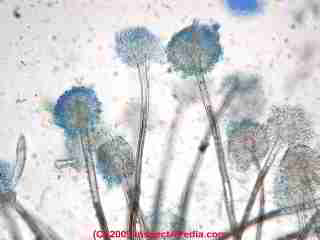 Our lab photo of Aspergillus sp. (below left) was made from a tape lift surface sample of mold growing in a building -- DF.
Our lab photo of Aspergillus sp. (below left) was made from a tape lift surface sample of mold growing in a building -- DF.
- 1974 - India - aflatoxicosis resulted in 106 deaths among 397 cases
Several outbreaks of aflatoxicosis have occurred in tropical countries, mostly among adults in rural populations with a poor level of nutrition for whom maize is the staple food. The clinical picture presented by cases indicated acute toxic liver injury, which was confirmed by morphological changes in liver autopsy specimens that were indicative of toxic hepatitis. Mortality rates in the acute phase were 10-60 %. At the end of one year, surviving patients had no jaundice, and most of them had recovered clinically. - Op.Cit. - 1975 - India - ergotism
The other type of ergotism, a convulsive form related to intoxication with clavine alkaloids from Claviceps fusiformis was last seen during 1975 in India when 78 persons were affected. It was characterized by gastrointestinal symptoms (nausea, vomiting and giddiness) followed by effects on the central nervous system (drowsiness, prolonged sleepiness, twitching, convulsions, blindness and paralysis). The onset of symptoms occurred 1-48 hours following exposure; there were no fatalities. - Op.Cit. - 1987 - India - gastrointestinal illness in the Kashmir valley from consuming mold-contaminated wheat products - Aspergillus sp. & Fusarium sp.
- 2004 - Kenya - 125 deaths from eating corn contaminated with Aspergillus flavus, aflatoxin contaminated - corn was stored in damp conditions
Use Common Sense in Avoiding Moldy Food Products
A general panic about possible mold in foods would be undue, misplaced, and an exaggeration.
Mold is everywhere, all the time. We do not live and should not try to live in a "mold free" environment - mycophobia contains its own risks. It is interesting to note that the incidence of asthma was found lowest among children of farmers whose environment contained very high levels of exposure to mold and other airborne allergens.
Seeking to protect our children by placing them in a "too-clean" environment in many instances actually increases the ultimate risk to their health from subsequent exposure to common mold and bacteria against which they will have developed no resistance.
Mold Growth on Lemon Slices in Water
That mold will grow in water is no surprise, there are plenty of water-molds. But when our lab frog reported that there were greenish-gray colonies floating on water in a pitcher of un-sweetened water with a dash of lemon we took a quick look and thought - gee it's a bit slimy but it sure looks like little Aspergillus colonies.
As Bob Tomasulo used to say with a grin, Wrong! Try again! As you can see below the fungus growing here was a species of Cladosporium - The King of Molds.
Mold Growth on Fresh Strawberries
Photographs above: typical mold growth on fresh strawberries. At above right is the dominant fungal material, hyaline fungal hyphae.
What Are the Potential Hazards from Eating Moldy Foods? - Mold Allergies, Mycotoxins, Aflatoxins, Ochratoxins & Bacterial Hazards in Food
But we certainly agree that there are potential hazards from ingesting mold in some specific cases:
The hazards from eating moldy food are
- Mold allergic-people: asthmatics, people with a mold allergy, compromised immune system, infant, elderly, especially to someone who has a severe mold allergy
- Mycotoxins, aflatoxins, ochratoxins etc: from food that contains mycotoxins, aflatoxins (chemically poisonous) (unlikely in dry pancake mix that has been properly stored) - we describe these substances in detail at World Health Organization Mold Bulletin
Mycotoxins are secondary metabolites of molds that exert toxic effects on animals and humans.
The toxic effect of mycotoxins on animal and human health is referred to as mycotoxicosis, the severity of which depends on the toxicity of the mycotoxin, the extent of exposure, age and nutritional status of the individual and possible synergistic effects of other chemicals to which the individual is exposed. The chemical structures of mycotoxins vary considerably, but they are all relatively low molecular mass organic compounds.
The untoward effect of molds and fungi was known already in ancient times. In the seventh and eighth centuries BC the festival "Robigalia" was established to honour the god Robigus, who had to be propitiated in order to protect grain and trees. It was celebrated on 25 April because that was the most likely time for crops to be attacked by rust or mildew - Op.Cit.Aflatoxins occur in nuts, cereals and rice under conditions of high humidity and temperature and present a risk to human health that is insufficiently recognized.
... Aflatoxins are acutely toxic, immunosuppressive, mutagenic, teratogenic and carcinogenic compounds. The main target organ for toxicity and carcinogenicity is the liver. The evaluation of epidemiological and laboratory results carried out in 1987 by the International Agency for Research on Cancer (IARC) found that there is sufficient evidence in humans for the carcinogenicity of naturally occurring mixtures of aflatoxins, which are therefore classified as Group 1 carcinogens, except for aflatoxin [M.sub.1], which is possibly carcinogenic to humans (Group 2B). - Op.Cit.Ochratoxins are secondary metabolites of Aspergillus and Penicillium strains, found on cereals, coffee and bread, as well as on all kinds of food commodities of animal origin in many countries.
The most frequent is ochratoxin A, which is also the most toxic. It has been shown to be nephrotoxic, immunosuppressive, carcinogenic and teratogenic in all experimental animals tested so far. ... Acute renal failure in one person, possibly caused by inhalation of ochratoxin A in a granary which had been closed for 2 years, was reported in Italy. - Op.Cit. - Bacteria found in the same food product: from that same food that may contain mold, there is a still higher risk of food poisoning from bacterial contamination such as by Staphylococcus aureus, Salmonella, Clostridium perfringens, Campylobacter, Listeria monocytogenes, Vibrio parahaemolyticus, Bacillus cereus, and entero-pathogenic Escherichia coli.
In general, moldy feed - grains - is particularly risky (more than say fruit) due to possible presence of mycotoxins or bacterial contamination.
But it's not simply the age of a product or throwing it away based on an expiration date that describe the risk. Even a new off the shelf product, particularly grain-based, that has been improperly stored under damp conditions, could be a risk. There could be a risk from buying a new grain product that itself was made from moldy raw product - say grain stored under damp conditions - but that seems to be less likely in countries where manufacturers are well aware of the hazard.
Ergotism is extremely rare today, primarily because the normal grain cleaning and milling processes remove most of the ergot so that only very low levels of alkaloids remain in the resultant flours. In addition, the alkaloids that are the causative agents of ergotism are relatively labile and are usually destroyed during baking and cooking. - Op.Cit.
To err on the side of caution, If your cake mix, bread mix, or pancake mix or any other food product looks or smells funny or moldy, or has been stored wet or damp just throw it away.
Putting Mold Related Illness Hazards in Perspective
Risk management: there are risks associated with mold exposure; certainly any large mold reservoir in a building (more than 30 sq.ft.. contiguous non-cosmetic mold) should be removed and its cause corrected -see ACTION GUIDE - WHAT TO DO ABOUT INDOOR MOLD.
And where people are at extra risk, extra care is needed to protect them from mold exposure - see MOLD / ENVIRONMENTAL EXPERT, HIRE ? for help in deciding when conditions justify bringing in a mold expert.
But don't forget these sources of immediate life-safety risk: lack of exercise, smoking, failure to install smoke and CO alarms in your home, failure fasten your seatbelt in the car, driving while texting, and falling down the stairs.
...
Continue reading at MOLD EXPOSURE STANDARDS or select a topic from the closely-related articles below, or see the complete ARTICLE INDEX.
Or see these
Recommended Articles
Suggested citation for this web page
MOLD EXPOSURE, FOOD HAZARDS at InspectApedia.com - online encyclopedia of building & environmental inspection, testing, diagnosis, repair, & problem prevention advice.
Or see this
INDEX to RELATED ARTICLES: ARTICLE INDEX to BUILDING ENVIRONMENT
Or use the SEARCH BOX found below to Ask a Question or Search InspectApedia
Ask a Question or Search InspectApedia
Try the search box just below, or if you prefer, post a question or comment in the Comments box below and we will respond promptly.
Search the InspectApedia website
Note: appearance of your Comment below may be delayed: if your comment contains an image, photograph, web link, or text that looks to the software as if it might be a web link, your posting will appear after it has been approved by a moderator. Apologies for the delay.
Only one image can be added per comment but you can post as many comments, and therefore images, as you like.
You will not receive a notification when a response to your question has been posted.
Please bookmark this page to make it easy for you to check back for our response.
IF above you see "Comment Form is loading comments..." then COMMENT BOX - countable.ca / bawkbox.com IS NOT WORKING.
In any case you are welcome to send an email directly to us at InspectApedia.com at editor@inspectApedia.com
We'll reply to you directly. Please help us help you by noting, in your email, the URL of the InspectApedia page where you wanted to comment.
Citations & References
In addition to any citations in the article above, a full list is available on request.
- World Health Organization bulletin: Human eases Caused by Mold - https://inspectapedia.com/mold/WHO_Mold_Bulletin.php
- Mold Exposure Standards - levels of allergenic & toxic mold: how much mold means a problem? - https://inspectapedia.com/mold/Mold-Exposure-Standards.php
- US EPA: Mold and Moisture - see http://www.epa.gov/mold/index.html
- Guidance for Clinicians on the Recognition and Management of Health Effects Related to Mold Exposure and Moisture Indoors, [on file as /mold/Mold_Guide_UConn.pdf] - Eileen Storey, MD MPH, Kenneth H. Dangman, MD PhD MPH, Paula Schenck MPH, Robert L DeBernardo MD MPH, Chin S Yang PhD, Anne Bracker CIH MPH, Michael J Hodgson MD MPH, University of Connecticut Health Center, Division of Occupational and Environmental Medicine, Center for Indoor Environments and Health, 266 Farmington Ave., Farmington CT 06030-6210, 30 September 2004. [We have edited this file to remove blank pages in order to speed its load-time and to add a link back to this website.] This document was designed to help the healthcare provider address patients with illnesses related to mold in the indoor environment by providing background understanding of how mold may be affecting patients. The guidance was published in 2004, with support from a grant by the U.S. EPA, by the Center for Indoor Environments and Health, or CIEH at the University of Connecticut Health Center. " -- original source: oehc.uchc.edu/images/PDFs/MOLD%20GUIDE.pdf (1.13MB PDF file, slow loading)
- History of major mold outbreaks: see the WHO bulletin above, also see a nice summary of the history of major mold related illness outbreaks is at moldbacteria.com/newsletters/2005/sep2005.html provided by Dr. Jackson Kung'U, a microbiologist, mycologist, writing for that website.
- Media Report of Student's Reaction to Consuming Suspected-Moldy-Pancakes - March 2010
A student at HBHS (high school) had pancakes and it almost became fatal. His mom (a registered nurse) made him pancakes, dropped him off at school afterward, and headed to play tennis. She usually never took her cell phone on the court, but did so this time, and her son called to say he was having trouble breathing. She told him to go to the nurse immediately and proceeded to call his school and alert the nurse. The nurse called the paramedics and they were there in 3 minutes. They worked on the boy all the way to the hospital. He came very close to dying. Evidently this is more common than I ever knew. Check the expiration dates on packages like pancakes and cake mixes that have yeast, which over time develop spores. Apparently, the mold that forms in old mixes can be toxic! Throw away ALL OUTDATED pancake mix, brownie mixes, Bisquick, cake & cookie mixes, etc., you have in your home.
P.S. Tell this to your children, grandchildren, nephews, nieces and anyone else who keeps these types of mixes in the cupboard.-- snopes.com/medical/toxins/pancake.asp - Our recommended books about building & mechanical systems design, inspection, problem diagnosis, and repair, and about indoor environment and IAQ testing, diagnosis, and cleanup are at the InspectAPedia Bookstore. Also see our Book Reviews - InspectAPedia.
- "IgG Food Allergy Testing by ELISA/EIA, What do they really tell us?" Sheryl B. Miller, MT (ASCP), PhD, Clinical Laboratory Director, Bastyr University Natural Health Clinic - ELISA testing accuracy: Here is an example of Miller's critique of ELISA - www.betterhealthusa.com/public/282.cfm - Townsend Letter for Doctors and Patients
The critique included in that article raises compelling questions about IgG testing assays, which prompts our interest in actually screening for the presence of high levels of particles that could carry allergens - dog dander or cat dander in the case at hand.
- www.tldp.com/issue/174/IgG%20Food%20Allergy.html - contains similar criticism in another venue but interestingly by the same author, Sheryl Miller. Sheryl Miller, MT (ASCP), PhD, is an Immunologist and Associate Professor of Basic and Medical Sciences at Bastyr University in Bothell, Washington. She is also the Laboratory Director of the Bastyr Natural Health Clinic Laboratory. - Allergens: Testing for the level of exposure to animal allergens is discussed at http://www.animalhealthchannel.com/animalallergy/diagnosis.shtml (lab animal exposure study is interesting because it involves a higher exposure level in some cases
- Allergens: WebMD discusses allergy tests for humans at webmd.com/allergies/allergy-tests
- Disease Prevention in Home Vegetable Gardens [PDF], Patricia Donald,Department of Plant Microbiology and Pathology,
Lewis Jett
Department of Horticulture, University of Missouri Extension - extension.missouri.edu/publications/DisplayPub.aspx?P=G6202 - In addition to citations & references found in this article, see the research citations given at the end of the related articles found at our suggested
CONTINUE READING or RECOMMENDED ARTICLES.
- Carson, Dunlop & Associates Ltd., 120 Carlton Street Suite 407, Toronto ON M5A 4K2. Tel: (416) 964-9415 1-800-268-7070 Email: info@carsondunlop.com. Alan Carson is a past president of ASHI, the American Society of Home Inspectors.
Thanks to Alan Carson and Bob Dunlop, for permission for InspectAPedia to use text excerpts from The HOME REFERENCE BOOK - the Encyclopedia of Homes and to use illustrations from The ILLUSTRATED HOME .
Carson Dunlop Associates provides extensive home inspection education and report writing material. In gratitude we provide links to tsome Carson Dunlop Associates products and services.


